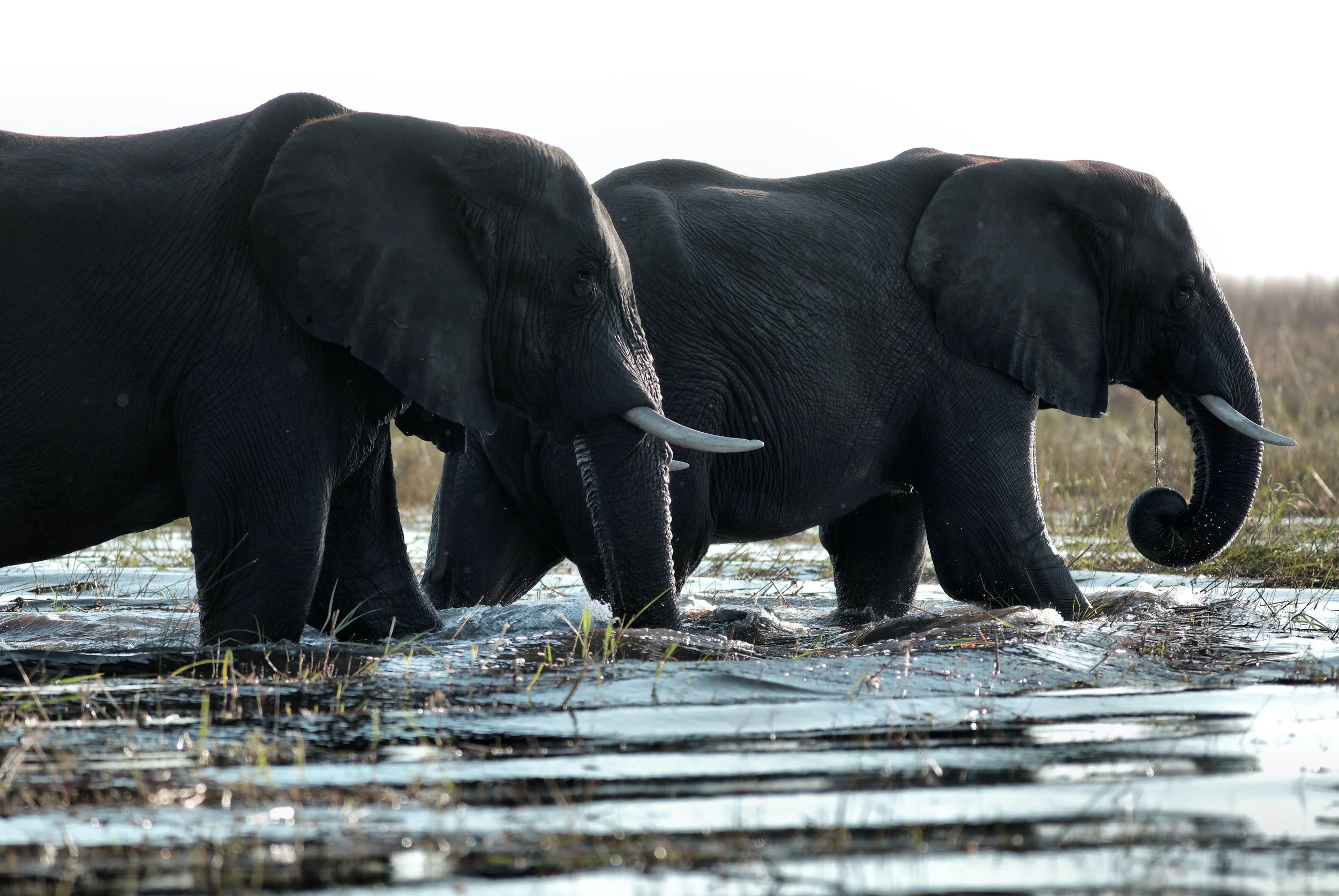Botswana tight lipped on mysterious elephant deaths from 2020
As first appeared in Sunday Standard in Botswana, here. Written by Thobo Motlhoka.
December 21 2022
At least 330 elephants died allegedly from consumption of bacteria toxins
Elephants crossing a stream in Kasane, northern Botswana.
I
mage by Wynand Uys.
Internal communication between authorities in Botswana’s northern Chobe region suggests the government may have tried to conceal information about the mysterious deaths of at least 57 elephants in 2020. A savingram between wildlife authorities in the region indicates authorities had long been informed about the deaths by the non-governmental organisation Elephant Without Borders (EWB).
A report was submitted to the Department of Wildlife and National Parks (DWNP) by the NGO in October. The report ‘Elephant Mortality in the Linyanti (CH1)’ says a total of 57 elephant carcasses were counted in the Linyanti (CH1), in northern Botswana. It says most carcasses were observed in the west of CH1, adjacent to Chobe National Park.
“GPS locations have been omitted from this report as 95% of the elephant carcasses still had their tusks intact. GPS points of the location of these fresh and recent elephant carcasses will be provided to DWNP, and law enforcement agencies,” EWB says in the report, which also contains visuals for all the 57 carcasses.
No public statement or communication has been made by the DWNP to date. An internal memo from Principal Veterinary Officer II Chobe to Regional Wildlife Officer Chobe however acknowledges the deaths.
“After Elephant without Borders report on the 16/09/2022 of elephant mortalities along the Linyanti River. From the 17/09/2022- 28/09/2022, Veterinary and Research Divisions officers, and Botswana Defence Force officers embarked on a search in the area to investigate and locate the sighted carcasses. 29 cumulative dead elephants were sighted during this exercise.” The savingram says it has come to the government’s attention from preliminary findings that both sexes and age are dying, saying all the discovered elephants had their tusks intact.
“It has also been observed that our natural water bodies are drying up and most of the carcasses are found in proximity or within these dried natural water bodies. Many of the carcasses are in an advanced stage of decomposition and resulting in sub-optimal samples. This results in degradation of pathogens before they reach the laboratory for testing.”
The communication between the authorities says fresh tissue material from multiple individuals would be ideal for pathogen discovery and species-specific detection.
“Sudden death in elephants can involve both infectious and non-infectious diseases. Poisonings could cause sudden death, but it is important to distinguish between deliberate and non-malicious poisoning causes. For example, ingestion of poisonous plants or exposure to toxigenic cyanobacteria spp. But the risk lies with exotic invasive plants, associated with human habitation e.g Nerium Oleander.”
The savingram says bio-intoxication by ingestion of toxigenic blue-green algae which produces either hepato-toxins or neurotoxins which can be rapidly fatal is another possibility, adding cyanobacteria may float as surface scum on the water or may be attached to sub-surface vegetation.
“Severe resource constraints during prolonged dry periods can result in mass deaths due to starvation. As it has been observed in the area, the elephants’ numbers are quite high, putting pressure on their habit which they share with other species in the area.” It says while the current elephant mortalities are continuing, thorough and speedy epidemiological patterns can be adopted in exploring disease transmission dynamics supported by detailed laboratory investigations for divisive strategies to prevent future mass mortality events.
“Locating fresh carcasses earlier for sampling and to assist with sampling of possible reservoirs of infection will help as to whether we are dealing with self-limiting or non-contagious agents. All this will determine whether mitigation strategies are called for or not.”
Efforts to get a comment from DWNP Director Dr. Kabelo Senyatso drew a blank as he would not respond to our inquiries. However he was quoted by international news agency Reuters as having said their mission was not to count all carcasses claimed by EWB but to sample carcasses.
“We have submitted samples to the national veterinary laboratory for testing,” Senyatso told Reuters.
At least 330 elephants died in Botswana in 2020 in what government officials said were a result of ingesting toxins produced by cyanobacteria.
This article is reproduced here as part of the African Conservation Journalism Programme, funded in Angola, Botswana, Mozambique, and Zimbabwe by USAID’s VukaNow: Activity. Implemented by the international conservation organisation Space for Giants, it aims to expand the reach of conservation and environmental journalism in Africa, and bring more African voices into the international conservation debate. Written articles from the Mozambican and Angolan cohorts are translated from Portuguese. Broadcast stories remain in the original language.

